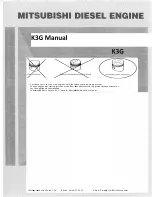
ECM SYSTEM
WG1605-G-E3,WG1605-L-E3,WG1605-GL-E3, DM
1-18
[2] LPG / NATURAL GAS SYMPTOM CHARTS
Important Preliminary Checks
Checks
Action
Before Using This Section
Before using this section, you should have performed On Board Diagnostic Check and determined
that:
• The Control Module and MIL (Malfunction Indicator Lamp) are operating correctly.
• There are no Diagnostic Trouble Codes (DTCs) stored, or a DTC exists, but without a MIL.
Several of the following symptom procedures call for a careful visual and physical check. The visual
and physical checks are very important. The checks can lead to correcting a problem, without further
checks, that may save valuable time. Most importantly talk to the operator about the failure this may
provide important information about the fault.
Important Question to Ask the
Operator
• When and how did the operator first notice the fault condition
• What engine speed and load condition did the fault occur at
• Did the fault occur just after or before refueling
• Did the fault occur at start up or shut down
• Did the fault occur at a particular time of day or during the shift
• Did the fault occur in a particular location
• Has there been any recent repair to the engine or vehicle
• Has the fault ever occurred before
• Has there been any new external customer installed devices added to the vehicle and or engine
LPG / Natural Gas Fuel System
Check
• Verify the customer complaint.
• Locate the correct symptom table.
• Check the items indicated, under that symptom.
• Operate the vehicle, under the condition the symptoms occurs. Verify HEGO is switching between
lean and rich.
IMPORTANT
•
Normal HEGO switching, indicates the LPG / natural gas fuel system is in closed loop, and
operating correctly at that time.
• If a scan tool is available,
take a snapshot
, under the condition that the symptom occurs. Go to
Engine Scan Tool Data List, to verify normal sensor values and parameters.
Visual and Physical Checks
• Check all ECM system fuses and/or circuit breakers.
• Check the ECM ground for being clean, tight, and in its proper location.
• Check the vacuum hoses for splits, kinks, and proper connections.
• Check thoroughly for any type of leak or restriction.
• Check for air leaks, at all the mounting areas, of the intake manifold sealing surfaces.
• Check for proper installation of the mixer module assembly.
• Check for air leaks, at the mixer assembly.
• Check the wiring, for the following items:
–
Proper connections, pinches, or cuts.
• Check the fuel level and fuel delivery system for leaks
• Check the battery condition
• The following symptom tables contain groups of possible causes, for each symptom. The order of
these procedures is not important. If the scan tool readings do not indicate the problems, then
proceed in a logical order, easiest to check, or most likely to occur first.
KiSC issued 12, 2016 A
Содержание WG1605-E3
Страница 1: ...WG1605 E3 DIAGNOSIS MANUAL ECM SYSTEM KiSC issued 12 2016 A...
Страница 3: ...I INFORMATION KiSC issued 12 2016 A...
Страница 4: ...CONTENTS 1 SAFETY FIRST I 1 INFORMATION KiSC issued 12 2016 A...
Страница 8: ...1 ECM SYSTEM KiSC issued 12 2016 A...
Страница 10: ...23 Spark Coil Primary DTC 2300 2301 2303 2304 2306 2307 2309 2310 1 228 KiSC issued 12 2016 A...
















































